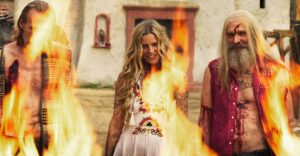Concrete Cowboy True Story: How Much Is Based On Real Life?

Netflix’s Concrete Cowboy may be fictional, but the movie is based on the true story of Black cowboys and horse riders who have existed in America for nearly a century. Using familiar movie tropes, namely westerns and father/son coming-of-age tales, Concrete Cowboy offers a refreshing take on the genres by chronicling the specific hardships of belonging to an often overlooked subculture. Indeed, few films in American history have given attention to Black cowboys, despite evidence that, according to the Smithsonian, many of the first cowboys in America were formerly enslaved Black people.
Tasked with telling the story of Concrete Cowboy is a stacked ensemble cast, led by Hollywood veterans Idris Elba and Lorraine Toussaint. The film also stars Stranger Things’ Caleb McLaughlin in his first leading movie role, opposite Elba, Golden Globe-winning actor Jharrel Jerome, and rapper-turned-actor Method Man. Concrete Cowboy centers on McLaughlin’s character, Cole, being sent to live with his estranged father, Harp (Elba), in Philadelphia. While spending time with his dad, Cole learns about the Fletcher Street Urban Riding Club, a community of Black cowboys that Harp belongs to. The plot on paper seems far-fetched — cowboys are typically viewed as a relic of the past, and they certainly aren’t remembered as Black men. But remarkably, the Fletcher Street Urban Riding Club is a real community of Black cowboys in Philadelphia.
Concrete Cowboy is a film adaptation of the novel Ghetto Cowboy by G. Neri, which itself is a fictionalized story of the lives of the riding club’s members. The film characters are the live-action counterparts to those in the book. Pulling from the real practices and traditions of the Fletcher Street Cowboys, Neri created the context for the story. In fact, the overarching conflict of the book — and thus, the film — is the increasing threat by city government to shut the group down. Unfortunately, this also rings true in real life.

The Fletcher Street Riding Club is currently facing pressure from Philadelphia government to surrender their land to the Philadelphia Housing Authority, who seeks to build high-end housing in its place. The riding club, founded over a century ago, cares for horses and offers youth education programs. If the club’s land is eliminated due to gentrification, Black cowboy and equestrian culture in Philadelphia would potentially cease to exist as well.
One of the striking aspects of Concrete Cowboy is its commitment to including the plight of the club’s actual members as part of the story. In addition to portraying the land conflicts between the riders and city government, a few of the real life Fletcher Street cowboys appear in Concrete Cowboy as well. In this way, the Netflix film takes the true story of the urban riding club a step further than G. Neri’s book.
Concrete Cowboy is a story of tensions both real and imagined. At the heart of this father-and-son redemption tale is the reality of Black cowboys past and present. Although they’ve largely been invisible in American culture, the Black horse riding community has thrived and created safe spaces to uplift one another. The sad reality of the Fletcher Street Riding Club is that its increased popularity may have inadvertently drawn the ire of people who refuse to respect its mission. Despite this, Concrete Cowboy may be the heartwarming western story that inspires a new generation of Americans to protect the legacy of Black cowboys for years to come.
About The Author

















